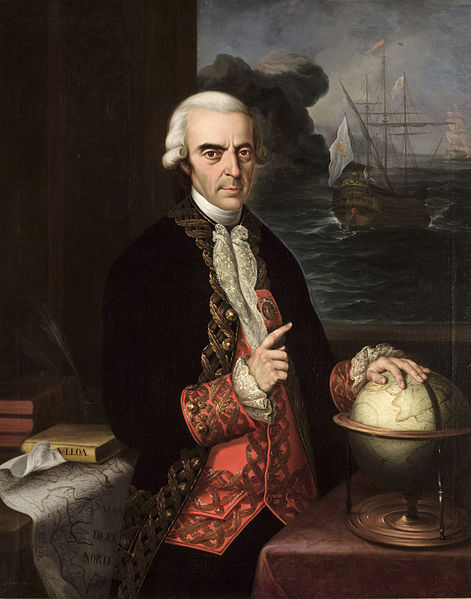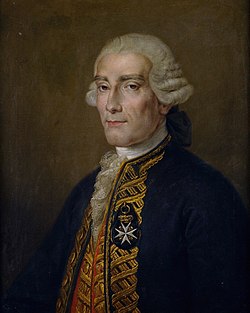Having just watched the celebrations for the Platinum Jubilee of Queen Elizabeth II, I remembered something that I read some time ago. There have been many ties and conflicts between British kings and queens and the royalty of Spain over the centuries, but this is a very incorruptible and noble one.
Antonio de Ulloa was born in Seville, Spain in January 1716. His father, Bernardo de Ulloa, was noted for his writings on economics, and his brother, Fernando, would become an engineer and the chief of works of the Canal de Castilla, a 207 km. long canal that runs through Burgos, Palencia and Valladolid. His family were outstanding and highly respected both in an aristocratic and intellectual context.
In 1729, thirteen-year-old Antonio embarked on the galleon San Luis in Cádiz, bound for the port of Cartagena de Indias in present-day Colombia. The young man was impressed by the seafaring life, and upon his return in 1733, he enrolled in the Real Compañía de Guardias Marinas (the Spanish Naval Academy) at the age of 17.
Longer voyages made it essential that ocean-going sailing ships needed to be able to accurately navigate a course on what was clearly a sphere. Straight lines were not straight, but curved in three dimensions, and drawing accurate flat charts a nightmare for cartographers.
There was an on-going battle of theories at the time: Descartes’ model, in which the earth was like a rugby ball with the poles further from the centre than the equator, and the Newtonian model, with the earth flattened at the poles. Newton published his Principia in which he calculated that the earth was an oblate spheroid with a flattening at the poles equal to 1/230th of the diameter at the equator.
To settle the argument, in 1735, the French Academy of Sciences organised two scientific expeditions. One to Quito, in present-day Ecuador, to measure the length of a degree of meridian arc at the equator. The other, to Lapland in the Arctic Circle, to measure a degree of arc there. They had already measured a degree of latitude in France, and now they needed to do the same in different parts of the globe and compare the three.
 Antonio de Ulloa
Antonio de Ulloa
Ulloa, and another young naval officer, Jorge Juan de Santacilia, were appointed by the Spanish Crown to accompany the French Geodesic Mission to Quito. This was by no means an easy posting. To make the observations the scientists would have to cut their way through dense jungle and climb mountains from whose peaks they would take the measurements. It did not help when the first leader chosen for the expedition spent a large part of the money allocated for provisions on a diamond for his wife.
 Jorge Juan de Santacilia
Jorge Juan de Santacilia
The expedition soon became bogged down in a plethora of problems. The first and most frequent problem was money, or rather the lack of it. Nobody had anticipated the problems of transport in the area they needed to cover, or the merciless corruption that existed within the Spanish government of Ecuador, who were supposed to give every assistance to the expedition. Another problem was the time it took to painstakingly set up the complicated instruments used to make the measurements. The members of the team argued frequently, but they managed to make the required observations, only to find that after two years work they had taken erroneous star sightings when setting up the equipment and the measurements were invalid. It took six month’s work to re-calibrate the instruments and re-take the measurements.
Things went from bad to worse in 1737 when Charles Marie de La Condamine, the leader of the French funded expedition complained bitterly to the president of the Real Audiencia de Quito, Joseph de Araujo y Río. As fellow Spaniards, Ulloa and Juan had been acting as go-betweens for the French, but Araujo ordered their arrest and announced his intention to have them murdered. The two men took refuge in a church, before escaping through the cordon of Araujo's men. They made their way to the coast and obtained passage on a Spanish boat going to Lima, Peru, where they gained the protection of the Viceroy of Peru, the Marquis of Villagarcía. Ulloa and Juan’s adventures were not over yet. Whilst they were in Lima waiting for a ship to return to Spain, war broke out between the Spanish and the British, and as officers in the Spanish navy, they were obliged to defend Peru.
The origins of the war, now known as The War of Jenkins' Ear, took place seven years earlier in 1731 when a Spanish patrol boat, La Isabela, part of La guarda costa, stopped and boarded the British brig Rebecca off the coast of Cuba. The Spanish captain, Juan de León Fandiño, accused the captain of the British ship, Robert Jenkins, of smuggling sugar. In an attempt to obtain more information about the illegal trade of the British, Fandiño tortured Jenkins and cut off one of his ears. Fandiño told Jenkins, "Go, and tell your King that I will do the same, if he dares to do the same." Seven years later, in March 1738, Jenkins was ordered to testify before Parliament, presumably to repeat his story before a committee of the House of Commons. As proof of the incident, he brought his severed ear. This incident, when considered alongside other cases of "Spanish Depredations upon the British Subjects", was considered an insult to Britain's honour and a clear and just cause for war. The war began in earnest in 1739 when the Royal Navy under Admiral Vernon sailed for the West Indies. On 22 October, British ships attacked La Guaira and Puerto Cabello, principal ports of the Province of Venezuela and Britain formally declared war on 23 October 1739.
The war was pretty much over by 1742, but was officially ended in 1748. Meanwhile, the conflict had hardly touched Ulloa and Juan. Though they had taken part in some very minor skirmishes, they had been allowed a free hand to do pretty much as they liked. Ulloa and Juan travelled extensively around Peru making many astronomic, natural, and social observations from 1736 to 1744. Meanwhile, the final results of French Geodesic Mission were published by La Condamine in 1745. These, combined with the measurements of meridian arc in Lapland near the Arctic Circle that had been published in 1738 by Pierre Louis Maupertuis decisively vindicated the predictions first made by Isaac Newton.
Now free to return home to Spain, Ulloa and Jorge Juan packed their samples and volumes of notes and prepared to sail in 1745. They decided to return on separate ships to minimize the danger of losing all their work if one ship was lost. Unfortunately the ship that Ulloa was travelling on was captured by the Royal Navy, and he was taken to England as a prisoner of war. Ulloa’s work had not gone unnoticed and he was visited and befriended in prison by other scientists. When he explained his work over the last ten years, Martin Folkes, the President of the Royal Society, stepped in and obtained his release. He was elected as a Fellow of the Royal Society of London in December 1746 and given permission to return to Spain.
In 1749, Ulloa published his Relación histórica del viaje a la América Meridional containing a full, accurate, and clear description of the greater part of South America geographically, and of its inhabitants and natural history. It was translated into English and published in 1758 as A Voyage to South America. Both Ulloa and Juan had been disturbed by the endemic corruption of the civil authorities and the Catholic clergy in their ruthless exploitation of the Native American population. They jointly wrote a secret letter to their political patron, the Marquess of Ensenada, but it remained unseen until 1826 when it was published in London by an Englishman named David Barry.
Ulloa continued his rise as an international scientist as his reputation grew. He still worked with Jorge Juan, and together the two friends established the first metallurgical laboratory in Spain along with the first museum of natural history and the astronomical observatory of Cádiz. In 1751, Ulloa was elected as a foreign member of the Royal Swedish Academy of Sciences. He returned to Peru in 1758 as governor of Huancavelica and manager of the mercury mines in the region. He fought against the deep-rooted corruption in the local administration before finally asking to be relieved of his post in 1764.
In 1756 the Seven Years War erupted with Spain and France trying to deny Great Britain dominance in world affairs and trade. This was a global war, which the Prussians and Austrians took advantage of and joined the fighting hoping for territorial expansion on land. Old disputes in Europe surfaced and loyalties changed frequently. Spain tried to invade Portugal who was aided by the British. Much of the naval fighting took place in the Caribbean and the Royal Navy took Havana for Britain and, half a world away, Manila in the Philippines. Finally, in 1763, the French were defeated and secretly signed the Treaty of Fontainebleau to cede to its ally Spain its remaining territories in North America.
The Spanish Crown appointed Ulloa as the first governor of Spanish Louisiana in March 1766 and shortly after arriving, fifty year-old Ulloa married Francisca Melchora Rosa Ramírez de Laredo y Encalada, daughter of the Count of San Javier y Casa Laredo; Ulloa had joined the nobility of Lima. Govenor of Louisianna turned out to be a very short appointment and one which must have alarmed his new wife. The French Creole colonists refused to recognise Spanish rule and riots broke out in New Orleans and the old French Superior Council voted that Ulloa and his wife should be given three days to leave.
This setback did not dampen Ulloa’s spirit, and he Returned to Spain where he and Francisca had six children. He was made Viceroyalty of New Spain (now Mexico) and supervised the construction of a military shipyard in the Atlantic port of Veracruz. Finally, in 1779, Ulloa was promoted to teniente general de la Armada (vice-admiral) and participated in the Siege of Gibraltar. The failure of the Spanish navy to prevent the British relieving Gibraltar led to charges of dereliction of duty against Ulloa and two captains under his command. Ulloa was later aquitted.
Antonio de Ulloa died in 1795 at the age of 79, and you might say that he had a platinum anniversary on his seventy-plus years of age. But that is not the link. When Antonio was roaming in the mountains of Peru he watched the gold panning operations in the Chocó region of what is now Colombia. He spotted shiny slivers of an unknown metal which he found in the sand of the rivers. He collected samples and made notes on the properties of the metal. It seemed to be immune to corrosion. He called the metal platina (little silver), and when he brought the samples back to Europe it was identified as a new element which was named Platinum. Ulloa is now credited as the discoverer of the noble element of Platinum.